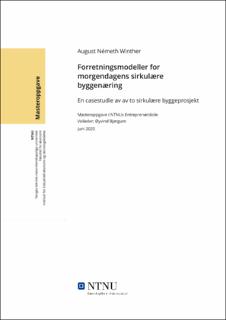| dc.description.abstract | Byggenæringen står for et høyt forbruk av råvarer, høy avfallsproduksjon, høyt energiforbruk og store CO2-utslipp. For å kunne bidra til å redusere verdens klimaavtrykk må byggenæringen utvikle nye løsninger og optimalisere verdikjeder. Ved at byggeprosjekter følger sirkulærøkonomiske prinsipper kan man legge til rette for god ressursutnyttelse og et syklisk livsløp for materialer og komponenter. Dette kan gjøre byggenæringen grønnere.
I dag er det en rekke utfordringer i verdikjeden til et byggeprosjekt som gjør det krevende å følge sirkulære prinsipper, og det er få norske byggeprosjekter som kan regnes som fullskala sirkulærøkonomisk. For å forstå hvordan man kan optimalisere den sirkulære verdikjeden i et byggeprosjekt er det interessant å studere hvilke forretningsmuligheter som kan gjøre det enklere å følge sirkulære prinsipper. Studiets formål er å kartlegge forretningsmuligheter som kan bidra til å gjøre byggenæringen sirkulærøkonomisk. For å besvare dette formålet er det utformet tre forskningsspørsmål:
• Hvordan kan byggenæringen få frem gode sirkulærøkonomiske initiativ?
• Hvordan kan aktører utvikle løsninger for sirkulære forretningsmuligheter?
• Hvilke strategier bør oppstartsbedrifter følge for å etablere seg i morgendagens sirkulære byggenæring?
Studiet er basert på en kvalitativ forskningsmetode og for å nå formålet er det utført datainnsamling gjennom observasjoner og semistrukturerte intervjuer. Studiet tar utgangspunkt i to sirkulære byggeprosjekter som på hver sin måte har høye sirkulære ambisjoner. De to case-prosjektene i oppgaven er Max-bygget i Trondheim og Kristian Augusts gate 13 (KA13) i Oslo.
Resultatene i studien presenterer åtte forretningsmuligheter hvor løsninger kan bidra til å gjøre byggenæringen mer sirkulærøkonomisk: kartlegging av bygninger, materialpass, materialbibliotek, markedsplass, teknisk testing og dokumentering, utleie av komponenter, logistikk av brukte materialer og sirkulærøkonomisk rådgivning. Funnene viser at alle åtte av de kartlagte forretningsmulighetene er en egnet mulighet for etablerte bedrifter, mens seks av de er egnet for oppstartsbedrifter. Studiet vurderer videre hvorvidt det er likheter mellom forretningsmulighetene og det argumenteres for at den komplekse omstillingen fra lineær økonomi til sirkulær økonomi også gir fellestrekk mellom forretningsmulighetene. Basert på disse likhetene fordeles forretningsmulighetene inn i de tre kompetansekategoriene byggeteknisk ekspertise, materialinformasjon og fysisk handling.
Den generelle konklusjonen for oppgaven er at nye løsninger tilknyttet de kartlagte forretningsmulighetene kan gjøre at byggenæringen kommer nærmere den sirkulærøkonomiske modellen. | |
| dc.description.abstract | The construction industry is responsible for a significant part of the world’s consumption of raw materials, waste production, energy consumption, and CO2 emissions. To help reduce the world's climate footprint, the construction industry must develop new solutions and optimize value chains. By building projects that follow circular economic principles, one can facilitate a better resource utilization and a cyclical life cycle for materials and components. Circular building projects can make the construction industry greener.
Today, several challenges make it demanding to follow circular principles, and few Norwegian construction projects are based on the circular economy. To understand which solutions and business models needed in the construction sector, it is necessary to study business opportunities. The purpose of the study is to identify business opportunities that can help make the construction industry to become circular economically. To answer this purpose, three research questions have been developed:
• How can the construction industry develop circular economic initiatives?
• How can actors develop solutions for circular business opportunities?
• What strategies should start-up companies follow to establish themselves in tomorrow's circular construction industry?
The study is based on a qualitative research method, and to achieve the purpose, data collection is conducted through observations and semi-structured interviews. The study is based on two circular construction projects that, in each way, have high circular ambitions. The two case projects in the thesis are the Max building in Trondheim and Kristian Augusts gate 13 (KA13) in Oslo.
The study results present eight business opportunities that can help make the construction industry more circular economical: mapping of buildings, material passports, material libraries, marketplaces, technical testing and documentation, rental of components, logistics of used materials, and circular consultancy. The findings show that all eight of the business opportunities are a suitable opportunity for established companies, while six of business opportunities are a suitable opportunity for start-ups. The study further assesses whether there are similarities between the business opportunities, and it is argued that the complex transition from linear economics to circular economics also provides composed business opportunities. Based on these similarities, the business opportunities are classified according to the three categories of competence, building technical expertise, material information, and physical action. The general conclusion for the study is that new solutions related to business opportunities can make the construction industry more circular. | |
